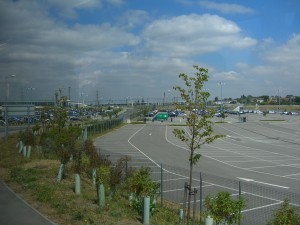Today, the National Audit Office published their report into the sale of Eurostar completed before the 2015 general election.

Ebbsfleet station car park, July 2011: HS1 has a third of the original predicted passenger numbers
Its worth noting that one of the main points they make is that the taxpayer investment in Eurostar was significantly greater than the proceeds of the sale. The press release says:
“However, the total taxpayer investment in Eurostar, prior to its incorporation, is significantly greater than the proceeds generated from this sale. Taxpayer spending on the HS1 project, of which Eurostar cross-channel train service is one part, was over £8 billion. The NAO estimates that UK taxpayers’ financial investment directly related to the Eurostar train service amounts to approximately £3 billion.”
The report contains a reminder that HS1 passenger numbers were lower than expected: https://www.nao.org.uk/wp-content/uploads/2015/11/The-sale-of-Eurostar-Summary.pdf
p5 “In 1996 the UK arm of Eurostar was transferred to London & Continental Railways (LCR), a private sector consortium, which planned to finance the building and operation of a new high-speed rail link between St Pancras and the Channel Tunnel. However, as the number of passengers using Eurostar was significantly lower than expected, LCR could not raise the private finance needed to build the link (now called High Speed 1 (HS1)). To keep the project alive taxpayer support was provided to LCR and the company was eventually nationalised in 2008.”
And it points out today’s report was one of a series of reports:
p6 “We have published three previous reports on the HS1 project, of which the UK stake in the Eurostar train service is one part. The aggregate proceeds from the sale of Eurostar, the previous sale of the HS1 track infrastructure and forthcoming sale of property assets will be significantly less than the taxpayer’s investment in the entire HS1 project. We have previously concluded that the benefits to transport users did not outweigh the costs of the HS1 project. The sale of Eurostar does not alter that assessment.”
They refer to the Government’s report on the economic benefits of HS1, pointing out that this was published two years late:
“The total taxpayer investment in Eurostar, prior to its incorporation, is significantly greater than the proceeds generated from this sale. Taxpayer spending on the HS1 project, of which the Eurostar cross-Channel train service is one part, was more than £8 billion. We estimate that UK taxpayers’ financial investment in Eurostar and its predecessors (including the write-off of losses incurred) amounts to approximately £3 billion. The Department for Transport (DfT) told the Committee of Public Accounts it would complete and publish an evaluation of the costs and benefits of the whole HS1 project by summer 2013. This document was published in October 2015 but was not available during our fieldwork so we have not commented on it in this report (Appendix Three, Figure 23).”
(The October report said that the costs of HS1 exceeded the benefits, with a cost benefit ratio of 0.53 meaning the benefits are half the costs. The published version was version 4.0, leading to speculation as to how critical of HS1 were version 1.0, 2.0 and 3.0).
The full report https://www.nao.org.uk/wp-content/uploads/2015/11/The-sale-of-Eurostar.pdf has some more interesting things to say, such as the timeline, which reminds us that in 1998 “Eurostar UK’s revenues are significantly lower than expected” and in 2007 the London terminus station moved from Waterloo (where the platforms are usually shuttered) to St Pancras International.
There was also discussion about the timing of the HS1 sale, with the NAO report saying:
p19 “the introduction of the new trains is forecast to increase profits from 2016, described as a ‘hockey stick’ increase in the government’s sale business case. This is because the new trains are forecast to increase revenue due to an increase in passengers while many of the costs will stay fixed (for example, track access costs per train) or fall (more cost-efficient trains). If the government had waited until the new trains had come into service (and investors could see these higher profits realised) it may have been able to get a higher price. Nevertheless, these forecast higher profits are dependent on new, unproven trains and an increase in the growth of passenger numbers. Eurostar’s borrowing will also need to increase to cover some of the investment costs.”
This is like the HS2 proposal, which relies on new, unproven trains and an increase in the growth of passenger numbers for the business case. Did the government rush the sale because they are not confident with their published forecast?
Although the report thinks the sale process was successful and achieved the stated aims, this does not mean that HS1 itself is a success. With significant costs to the taxpayer of construction, a failure to consider the wider context leading to overoptimistic passenger numbers and a benefit-cost ratio of just 0.53 for HS1, the question mark over HS2 should be getting bigger and bigger.
Downloads from the NAO site

This is a link to a parliamentary question on spend to date on hs2
Apart from the jaw dropping total what are they capitalising and what is the write down formula
Capital spending is still borrowed money
http://www.theyworkforyou.com/wrans/?id=2015-11-02.14447.h&s=high+speed+2#g14447.r0